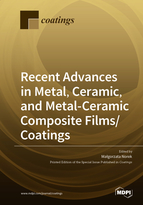Recent Advances in Metal, Ceramic, and Metal-Ceramic Composite Films/Coatings
A special issue of Coatings (ISSN 2079-6412). This special issue belongs to the section "Corrosion, Wear and Erosion".
Deadline for manuscript submissions: closed (31 January 2022) | Viewed by 33237
Special Issue Editor
Interests: nanostructures; anodization; surface properties; optical materials
Special Issues, Collections and Topics in MDPI journals
Special Issue Information
Dear Colleagues,
The application of various metal, ceramic, or metal–ceramic composite coatings is currently considered as the one of the most effective methods to tailor surface properties of materials to specific requirements for conventional and advanced technological applications. The well-defined surface properties induced by various coating layers can change mechanical (e.g., hardness, fatigue limit, elongation, tensile strength), thermal (e.g., thermal conductivity, expansion), electrical, and many other functional properties of materials (corrosion resistance, hydrophobicity or super-hydrophobicity, wettability, optical properties, etc.) without the necessity of using expensive and time-consuming heat treatments or alloying techniques. Metal coatings are successfully used in photovoltaics, optical, energy conversion, and sensing devices. Ceramic coatings create a barrier on the substrate that separates the material from the corrosive environment, thus enhancing its corrosion resistance. Additionally, the coatings provide better abrasion resistance that makes them extremely robust and ensures a longer life for the coated surface. Moreover, the coatings can modify surface texture for specific needs, enhance wettability/hydrophobicity, provide better wear resistance and thermal/electrical insulation, and improve surface hardness of a given material. Application of various coatings is, therefore, an efficient and affordable method to obtain the desired surface and material properties for a broad range of applications.
In particular, the topics of interest include but are not limited to:
- The effect of thin coatings on mechanical properties of bulk materials;
- New directions in design and production of hard coatings;
- Thermal barrier coating (TBC) to prevent heat loss;
- Smart and self-healing coatings for corrosion protection;
- Super-hydrophobic and self-cleaning coatings;
- High refractive index (HRI) coatings;
- Plasmonic and antireflecting coatings;
- Single and multilayer films;
- Coating methods and technologies.
Dr. Małgorzata Norek
Guest Editor
Manuscript Submission Information
Manuscripts should be submitted online at www.mdpi.com by registering and logging in to this website. Once you are registered, click here to go to the submission form. Manuscripts can be submitted until the deadline. All submissions that pass pre-check are peer-reviewed. Accepted papers will be published continuously in the journal (as soon as accepted) and will be listed together on the special issue website. Research articles, review articles as well as short communications are invited. For planned papers, a title and short abstract (about 100 words) can be sent to the Editorial Office for announcement on this website.
Submitted manuscripts should not have been published previously, nor be under consideration for publication elsewhere (except conference proceedings papers). All manuscripts are thoroughly refereed through a single-blind peer-review process. A guide for authors and other relevant information for submission of manuscripts is available on the Instructions for Authors page. Coatings is an international peer-reviewed open access monthly journal published by MDPI.
Please visit the Instructions for Authors page before submitting a manuscript. The Article Processing Charge (APC) for publication in this open access journal is 2600 CHF (Swiss Francs). Submitted papers should be well formatted and use good English. Authors may use MDPI's English editing service prior to publication or during author revisions.
Keywords
- metal thin films
- metal-ceramic composite
- functional coatings
- multilayers






